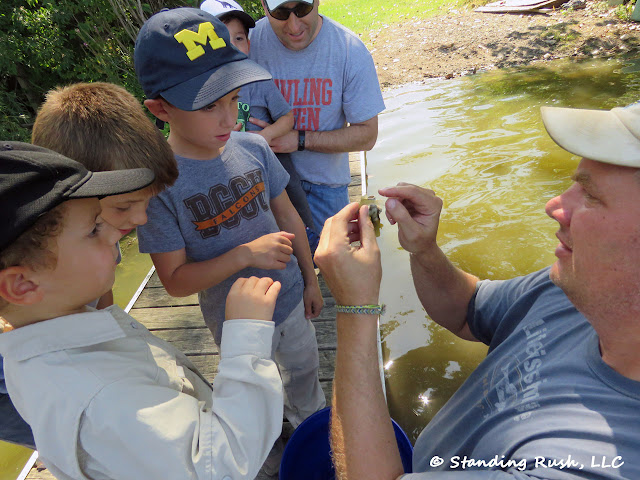 |
The ever-striking Common Gallinule is becoming that much more common at Standing Rush thanks to expansion
of desirable vegetative habitat (and all the shelter and food options that come with a diversity of native plants) |
Despite significantly shorter day length and considerably more hours of darkness in the evening, (candidly) it has still been a major challenge to regain the discipline of regular journal entries. Per usual, it's not for a lack of activity in and around the marsh. [More than at any time in this project's five years, I also continue to be very busy at my desk planning for future improvement opportunities.]
 |
These types of distinctions, while always
appreciated, are a tangible reminder
of the importance of collaboration
-- no great work happens
in a vacuum |
The images above and immediately below are in recognition and appreciation of an evening well-spent this past Saturday. I was invited as a guest of the
Firelands Audubon Society to its
Lake Erie Wing Watch banquet in Huron, Ohio to receive its conservation award on behalf of Standing Rush. A passionate ~125 attendees filled a room surrounded by exhibitors displaying all things birds. A very talented and articulate keynote gave an incredible talk about an entire year fully devoted to birding. But as I settled in to dig into my delicious meal (including homemade elderberry pie!), it became obvious that this group extends its enthusiasm not only to their ultimate pursuits -- the birds -- but to everything it takes to support their well-being.
It was an honor, of course, to be recognized for our efforts, but even more so, it was an honor to spend some time with this group. Our paths officially crossed when a couple of their active members -- Bill and Dorthy Baker -- took a tour of Standing Rush as part of the
Biggest Week in American Birding this past spring. Their friendliness, enthusiasm, active curiosity, and professionalism all contributed to their instant appeal. And now we can hopefully add another talented group to a growing list of collaborators. We look forward to the opportunity to tour them on-site soon!
 |
With so many projects going on simultaneously, we just haven't been as diligent about taking (and sharing) wildlife images;
that doesn't mean we haven't enjoyed watching broods like these gallinules grow up before our very eyes |
Other highlights over the last few weeks include:
- Annual fish sampling in and adjacent to Standing Rush's West Marsh (once again in conjunction with BGSU's Fisheries & Aquatic Ecology lab and some scientists in-training);
- installation of an initial pipe and screw gate to provide targeted connectivity between Standing Rush and an adjacent agricultural drainage ditch (to intercept storm water runoff before it enters Sandusky Bay);
- berm rehabilitation on the interior of our West Marsh's bayfront dikes (including earthwork and seeding);
- the start of another waterfowl season: with persistent hot and humid weather, teal and early goose season opened somewhat unceremoniously the weekend before last -- there have been a few mornings of activity (coinciding with brief cool-downs) thus far; we're optimistic that the best is yet to come . . . there's a lot of duck season ahead of us.
 |
The fish does not have to be big to capture one's attention; here we count rigid dorsal rays of a yearling crappie
to distinguish black from white |
 |
Fish sampling once again took the form of multiple, strategically placed Fyke nets and a good amount of seining;
plans to electrofish just outside our new water conveyance to the bay were scrapped due to high winds,
but the usual late-summer suspects were still identified, tallied, and released within the marsh |
 |
The nondescript pipe at the center of this image may look pretty uninspiring, but we hope it will be the start of some
really exciting water quality improvement opportunities at and around Standing Rush |
 |
This image was taken to document the amount of debris (mostly bladderwort and cattails) caught by the debris screen
in front of our new pump in just a few short hours, but the background is a good visual of the extra protection
provided by recent berm rehabilitation efforts (lower marsh water level to left; elevated bay water level to right) |
 |
Just like the early arrival of teal, seeding dikes is starting to feel like an annual right of passage;
like so many things that Roy does quietly and without fanfare around the marsh,
his careful attention now will bear dividends later |








